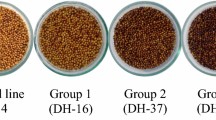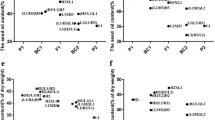Summary
Microspore embryogenesis technology allows plant breeders to efficiently generate homozygous micros-pore-derived breeding populations of oilseed rape (Brassica napus L.) without traditional generations of inbreeding. This study was conducted to compare the frequency distribution of microspore-derived population and single seed descent populations with respect to fatty acids of seed oil. Both microspore-derived populations and single seed descent populations were produced from each of three crosses made between selected parents containing contrasting amount of erucic, oleic, linoleic and linolenic acids. The fatty acid content of F3 plants derived lines (F5 seed) developed by single seed descent was compared to that of microspore-derived populations. The means, ranges and distribution pattern of seed fatty acid contents were similar in both populations for each fatty acid studied, although a few heterozygous lines were observed in the single seed descent populations. The results indicated that microspore-derived population form random, homozygous F1 plant derived gametic arrays for all fatty acids evaluated. Selection for altered fatty acid composition in microspore-derived and single seed descent homozygous populations should be equally efficient, in the absence of linkage of traits investigated.
Similar content being viewed by others
References
Arcia, M.A., E.A. Wernsman & L.G. Burk, 1978. Performance of anther derived dihaploids and their conventionally inbred parents as lines, in F1 hybrids, and in F2 generations. Crop Sci. 18: 413–418.
Brim, C.A., 1966. A modified pedigree method of selection in soybeans. Crop Sci. 6: 220.
Brown, J.S. & E.A. Wernsman, 1982. Nature of reduced productivity of anther-derived dihaploid lines of flue-cured tobacco. Crop Sci. 22: 1–5.
Burk, L.G. & D.F. Matzinger, 1976. Variation among anther-derived doubled haploids from an inbred line of tobacco. Heredity. 67: 385–388.
Choo, T.M., E. Reinbergs & S.J. Park, 1982. Comparisons of frequency distributions of doubled haploid and single seed descent lines in barley. Theor. Appl. Genet. 61: 215–218.
Daun, J.K., P.B. Mazur & C.J. Marek, 1983. Use of gas chromatograph for monitoring the fatty acid composition of Canadian rapeseed. JAOCS 60: 1751–1754.
Deaton, W.R., P.D. Legg & G.B. Collins, 1982. A comparison of burley tobacco doubled-haploid lines with their source inbred cultivars. Theor. Appl. Genet. 62: 69–74.
Downey, R.K. & G.F.W. Rakow, 1987. Rapeseed and Mustard. Principles of plant breeding. Vol. 2: 437–486.
Jinks, J.L. & H.S. Pooni, 1981. Properties of pure breeding lines produced by dihaploidy, single seed descent and pedigree method. Heredity 46: 391–395.
Lichter, R. 1981., Anther culture of B. Napus in a liquid culture medium. Z. Pflanzenphysiol. 103: 229–237.
Lichter, R. 1982., Induction of haploid plants from isolated pollen of Brassica napus. Z. Pflanzenphysiol. 105: 427–434.
Polsoni, L., L.S. Kott & W.D. Beversdorf, 1988. Large scale microspore culture technique for mutation/selection studies in Brassica napus L. Can. J. Bot. 66: 1681–1685.
Siebel, S., 1956. Nonparametric statistics for the behavioral sciences. pp 121–124. MaGran-Hill book company. New York Toronto London.
Simmonds, N.W. 1979., Principles of crop improvement. Chapter 5. Longman, London & New York.
Thompson, K.F. 1983., Breeding winter oilseed rape, Brassica napus. Adv. Appl. Biol. 7: 1–104.
Vles, R.O. 1975., Nutritional aspects of rapeseed oils. Proc. 4th Int. Rapeseed Conf. Giessen, W. Germany 1974: 17–30.
Author information
Authors and Affiliations
Rights and permissions
About this article
Cite this article
Chen, J.L., Beversdorf, W.D. A comparison of traditional and haploid-derived breeding populations of oilseed rape (Brassica napus L.) for fatty acid composition of the seed oil. Euphytica 51, 59–65 (1990). https://doi.org/10.1007/BF00022893
Received:
Accepted:
Issue Date:
DOI: https://doi.org/10.1007/BF00022893




